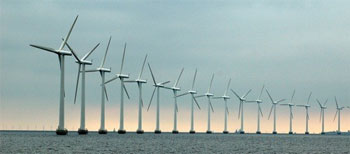Under the United Kingdom’s new national
infrastructure plan released this week, the government is shifting
incentives toward offshore wind power—and away from projects on land that raise objections from local residents.
The UK government expects to invest $65
billion in renewable energy by 2020 and is raising "strike prices" for offshore wind, while lowering them for onshore wind farms and solar parks.
A "strike price" is the guaranteed amount energy generators earn when they sign long-term power contracts, similar to power purchase agreements in the US.
Starting in 2018, the strike price for offshore wind will be raised by $8 per megawatt hour (MWh) to $228 per MWh.
DECC also wants to raise incentives for companies and communities that install renewable energy facilities that provide heat – biomass boilers bigger than 1 megawatt; deep geothermal; combined heat and power plants, ground-source heat pumps, solar thermal installations and biogas burners.
Renewable energy (including hydro) reached its highest level yet in the UK during the third quarter, providing 13.2% of the country’s electricity, up from 11.7% from Q3 2012. About 20 GW of renewable energy is installed in the UK and 11 GW more is in the pipeline for wind, both onshore and offshore.
But residents in rural areas are against big onshore wind farms and solar parks. In this small nation, they scar the landscape, introduce noise into formerly quiet communities, and threaten wildlife.
How will residents respond to the fact that the government plans to license two-thirds of the country’s land for natural gas fracking?! Energy companies that have already expressed interest are expected to apply for licenses that would cover 15% of the land in the UK, reports The Guardian.
Final prices for the various renewable energy sources have been published and go into effect April 2015. For the binding and kept at that rate, finally giving developers certainty about what they will earn.
“It is vital that we get the level of support right so the market can invest with confidence, cost reductions can be achieved and the market can grow sustainably,” Gregory Barker, Minister of State for Energy and Climate Change wrote to UK’s Parliament.
The UK already leads the world in offshore wind with nearly 3 gigawatts (GW) installed as of 2012 – more than the rest of the world put together. This year, the first phase of London Array – the world’s largest offshore wind farm – came online, bringing electricity to 500,000 homes.

Deploying 10 gigawatts by 2020 is achievable, says the Department of Energy and Climate Change (DECC), although it hasn’t necessarily set that as a target.
“This package will deliver record levels of investment in green energy by 2020,” Ed Davey, Secretary of State for Energy and Climate Change told Bloomberg. “Our reforms are succeeding in attracting investors from around the world, so Britain can replace our aging power station[s] and keep the lights on.”
The government has to invest $180 billion to replace aging power stations and meet renewable energy and carbon targets.
Earlier this year, the government announced it would pay higher amounts to communities that host onshore wind farms, and also introduced guidance that makes sure affected residents are brought in early in the decision process.
"Cuts to onshore wind and solar support schemes show how quickly the cost of clean energy technologies are falling,” Doug Parr, Policy Director of Greenpeace told Bloomberg. “It’s right ministers should now put emphasis onto helping drive down the cost of offshore wind so that the UK can reap the rewards of new turbine factories and thousands of new jobs.” Offshore wind costs about double the price of onshore wind today.
Read our article, UK Lawmakers Reach ‘Landmark Deal’ On Renewable Energy Support.

